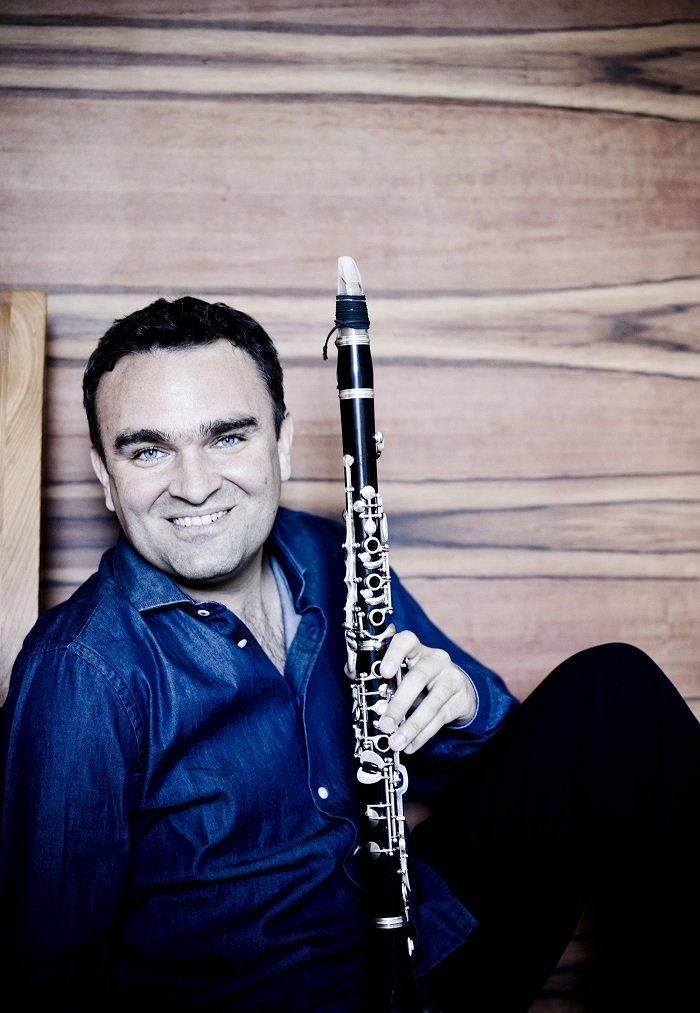Apparently it was Mirga Gražinytė-Tyla’s idea to invite Jörg Widmann to be the City of Birmingham Symphony Orchestra’s Artist in Residence this season – indeed, according to backstage rumours she made the phone call herself. If that’s true, it’s a hugely encouraging bit of intelligence. Widmann’s the perfect choice of artist to surf the energy that Gražinytė-Tyla is currently generating in Birmingham. He’s a charismatic soloist, and a composer of music with real potential audience appeal: flamboyant, vivid, grounded in (but never inhibited by) tradition, and madly in love with the sound of a symphony orchestra. It’s the kind of stuff that contemporary music bores dismiss as too derivative by half, and none the worse for it.
Gražinytė-Tyla hit us with it good and strong, with a performance – billed as the “English premiere”, the orchestra of Welsh National Opera having played it in Cardiff last year – of Widmann’s sprawling, shamelessly lavish Babylon Suite. Ostensibly a medley of orchestral highlights from Widmann’s 2012 opera Babylon, the scale of this crazily eclectic 40-minute single movement is reminiscent of the symphonies that Hindemith derived from his operas. But the resemblance ends there. Widmann’s supersized orchestra features two harps, accordion, a wall of tuned percussion and apparently (though I couldn’t hear them) a pair of ocarinas.
 As for his musical language; well, it’s almost easier to list the styles that he doesn’t reference. Widmann cheerfully plunders the wreckage of two centuries of musical civilisation, and Max Steiner, John Adams and Miles Davis are as central to his world-view as the more predictable suspects, Mahler, Strauss, Shostakovich and the Second Viennese School. Yearning romantic melodies rise hazily in the distance; a solo violin fiddles manically over a folk tune. Salome exits pursued by a Tom and Jerry scherzo, muted trumpets and high clarinets squawk derisively at a strutting Prussian march, and rasping gongs tear ominously through the texture of ever grander Hollywood climaxes.
As for his musical language; well, it’s almost easier to list the styles that he doesn’t reference. Widmann cheerfully plunders the wreckage of two centuries of musical civilisation, and Max Steiner, John Adams and Miles Davis are as central to his world-view as the more predictable suspects, Mahler, Strauss, Shostakovich and the Second Viennese School. Yearning romantic melodies rise hazily in the distance; a solo violin fiddles manically over a folk tune. Salome exits pursued by a Tom and Jerry scherzo, muted trumpets and high clarinets squawk derisively at a strutting Prussian march, and rasping gongs tear ominously through the texture of ever grander Hollywood climaxes.
In short (which it certainly isn’t), the Babylon Suite is a glorious Technicolor mess, ambitiously conceived and dazzlingly orchestrated. Gražinytė-Tyla and her orchestra played the socks off it, drawing enthusiastic applause for a work which, performed with even slightly less conviction, could easily have outstayed its welcome. Half the battle, of course, is that the audience was willing to be convinced – a secret that the young Simon Rattle discovered in Birmingham three decades ago when he championed similarly improbable modernist one-offs like Robin Holloway’s Clarissa Symphony and Nicholas Maw’s Odyssey. Long-serving Birmingham audience members are already speaking of Gražinytė-Tyla in the same terms: moments like this show you why.
Still, it probably helped that we’d just seen Widmann (pictured above right) as soloist in Mozart’s Clarinet Concerto (the notion of starting a concert with a concerto feels perfectly natural with Gražinytė-Tyla). He’s a smiling, buoyant presence on stage, responding to each section of the orchestra in turn, locking eyes as well as semiquavers with the strings, and moulding melodies and passagework alike with a lithe, transparent tone. This was one of the least indulgent Mozart clarinet concertos I’ve heard, and its special grace lay in the unforced way Widmann, Gražinytė-Tyla and the orchestra played off each other. She has a wonderful way of making classical rhythms dance and whole phrases sing: ornaments, with Gražinytė-Tyla, are never merely decorations. The result was fresh, translucent, and utterly unaffected.
That same instinct for classicism defined her reading of Brahms’s First Symphony, after the interval. Gražinytė-Tyla appears to see the symphony as a single huge arc, and the opening bars had an irresistible forward momentum. The first movement swept by in taut, streamlined paragraphs, with Gražinytė-Tyla making full use of the rich string sound bequeathed to her by Sakari Oramo and Andris Nelsons to shape an argument that was entirely her own. That meant an Andante that was a muscular continuation of the first movement’s struggle; and a third movement that, with ominous trumpets and steadily rising tension, served as extended preparation for the finale. There was no letting up here, either: Elspeth Dutch (horn) and Marie-Christine Zupancic (flute) were powerfully assertive in their big solos. With the second violins sitting on the outside of the orchestra, the great theme of the Allegro sounded duskier than usual, and even as Gražinytė-Tyla accelerated into the coda, there was no sense of an easy resolution: the stakes remained as high as anywhere in the drama.
Such a single-minded reading won’t have been to all tastes, and Gražinytė-Tyla might well approach Brahms differently in five or 10 years’ time. For now, though, her long-range vision and formal command are beyond question, and so too is the way in which she takes both audience and orchestra along with her. The silence between movements practically crackled. And that ability to create a collective enthusiasm – a shared sense of adventure – is what makes Gražinytė-Tyla’s concerts in Birmingham some of the most life-affirming experiences on the UK concert scene right now. You never quite know what she’ll spring on you, but every single concert is an occasion – and one that you don’t want to miss.















Add comment